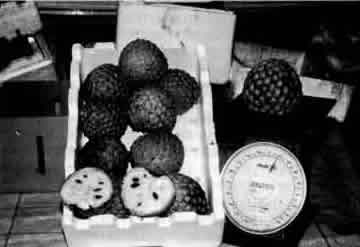
An Update on the
Posh-te
Scientific
name: Annona
scleroderma
Family:
Annonacaea
Don and I received a letter from Thea, our Editor of the Rare
Fruit Council of Australia Inc. Newsletter. Thea told us in her letter
that she has received a lot of requests for a follow-up article on the
posh-té.
It is Sunday August 19th, 1990. We have been having a cool winter here
in Julatten.
The
posh-té tree has gone through the winter without showing any
signs of stress. The lowest temperature was 4°C so far this
winter.
The posh-té tree is beautiful and dark green. The tree never
seems to loose its cover of thick foliage. The application of mill mud
and molasses helps to lengthen the time between watering.
I have
picked a leaf. It is dark green and shiny. The underside of the leaf is
without the polished shine; it is of a paler green with a touch of
browny-gold. The underside veins are greeny-yellow. The leaf measures
from end to end 22cm long and 7.5cm wide (8¾ inches by
3¼
inches). The leaves look like soursop leaves, but the
posh-té
leaves are at least twice as large. (The soursop tree has lost many
leaves, baring branches this winter; the posh-té has not
lost
any leaves).
The flowers of the posh-té are much like a
custard apple flower, but the petals are slightly brown-tinged, and
seem to be longer than a custard apple flower. We do not know what
pollinates the flowers. It could be beetles, flies or bees. The tree
having such dense foliage must help to lengthen the time of stigma
receptivity, as the humidity would be kept reasonably high. The flowers
coincide with the moist months of January and February here (though we
have had some dry Januaries and Februaries).
So far this season,
the posh-té fruit are forming well. Some of the fruit are
already 6½ cm in diameter (2½ inches). There is
quite a
good crop. We have noticed some fruit turning black and going hard. We
can only presume that this is a natural thinning process, as the tree
can only hold so many fruit.
In my previous article, we did not
write what we thought of the flavour of the fruit. We always prefer
people to tell us what they think the flavour is like, but after
reading the article 'Cawesh' in the May Newsletter, we have to agree
that the flavour is much like a monsterio.
Some of the fruit we
picked last season in November, 1989, were approximately 8½
cm
or 3½ inches in diameter. We did not weigh the fruit, but
will
take particular note when we pick its second crop in October/November,
1990.
The hard shell encasing the fruit was approximately ⅛ to
¼ inch, 2mm to 4mm thick. This also we will measure and make
sure when we pick some posh-té.
We have made enquiries
about where the posh-té tree came from. Don's friend who
gave
him the original piece of grafting wood, said the D. P. l. gave him the
tree. Don phoned Alan George from the D. P. I. at Nambour and he said
he thinks the seed came from a tree in southern Mexico, but he was not
sure, as they give out trees all the time. Right now the
posh-té
tree which we first planted is close to 6m high. Don has planted out
other grafted posh-té trees all from the original grafted
tree.
They range in all sizes and some have fruit on them also.
The rootstock is very good. It is a type of bullocks heart. We call it
Mexican soncoya.
The
posh-té is really something different. It has been said that
one
should not judge a tree by its first fruiting. WE are looking forward
to tasting the posh-té's second fruiting in October/November.

Box of large Posh-Te fruits Nov. 1999.
Post Script:
February 2000
The fruiting season for the Posh-Te in 1999
was most successful in our orchard. The fruit were the largest we have
recorded.
Most
of the fruit weighed between 500g to 1 kg. The flavour was super, sweet
with a sharp tang of lemon and many other fruity flavours.
I
have put down the larger fruit to the following reasons: Thinning the
fruit when small, early fertilizing in June with organic fertilizer,
regular watering once a week a good soaking.
Back to
Poshte
Page
|

